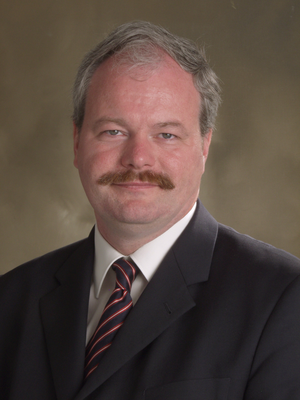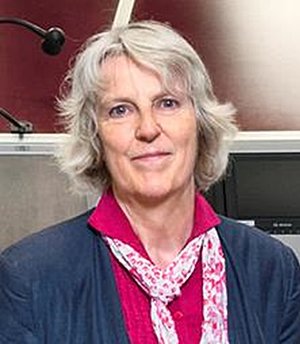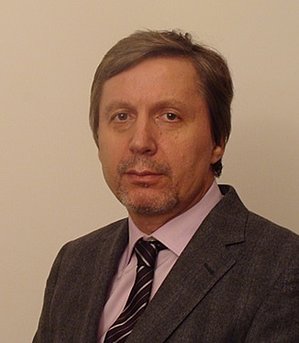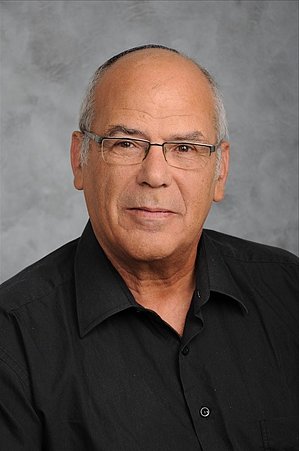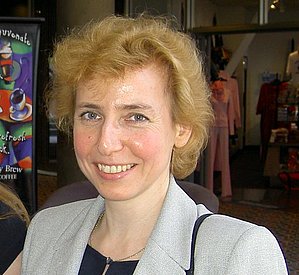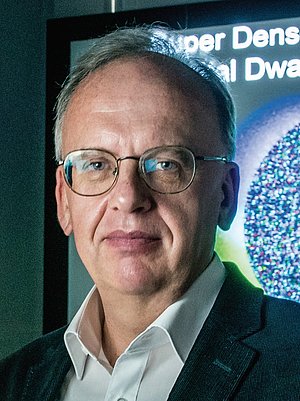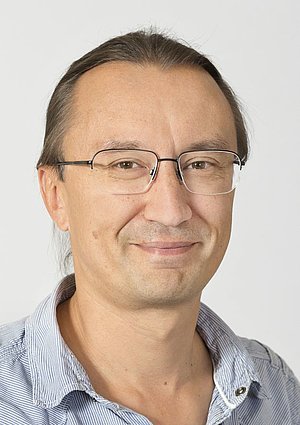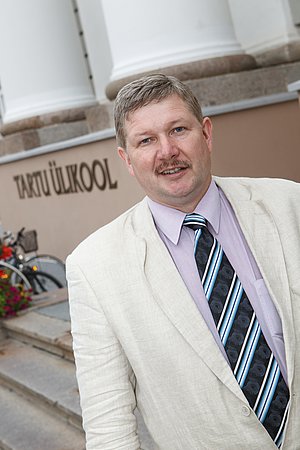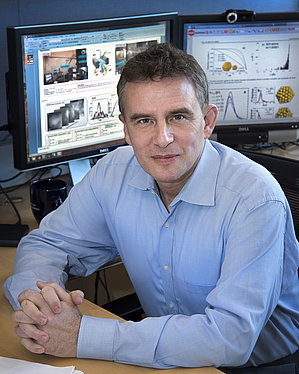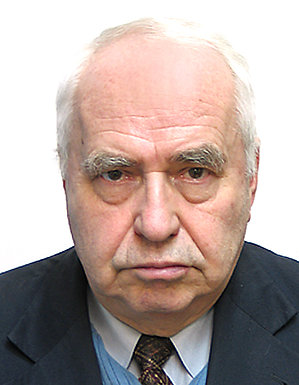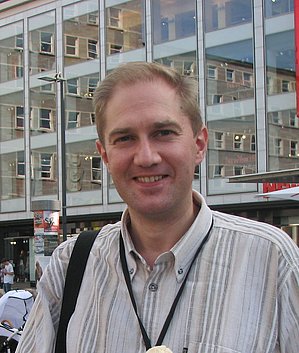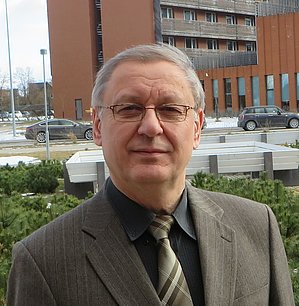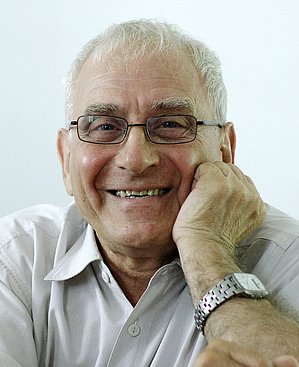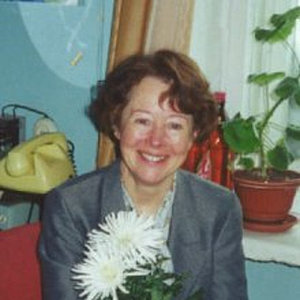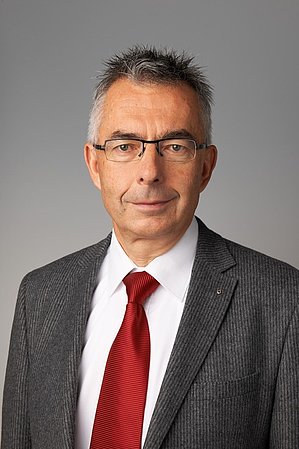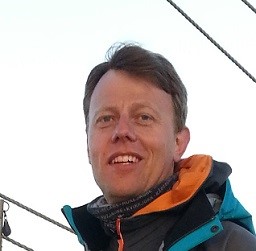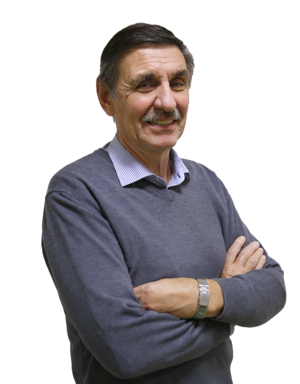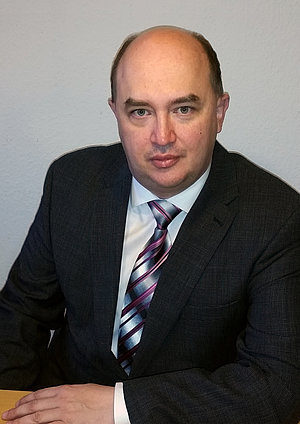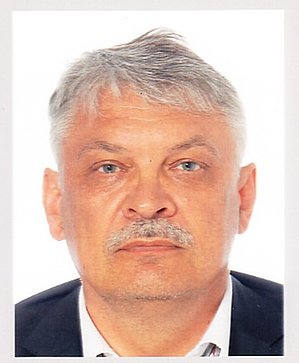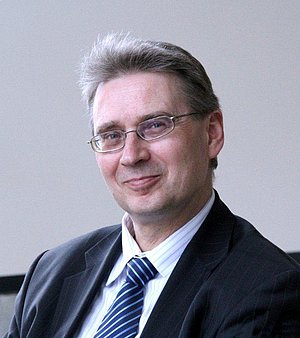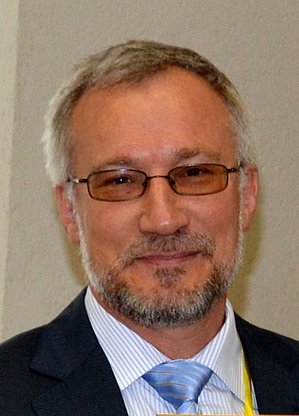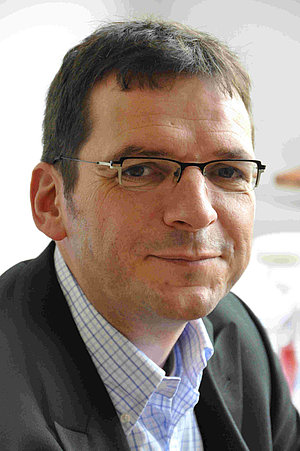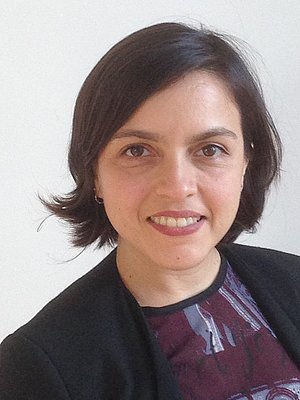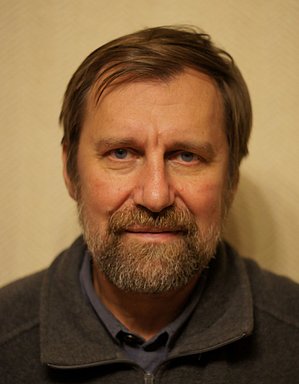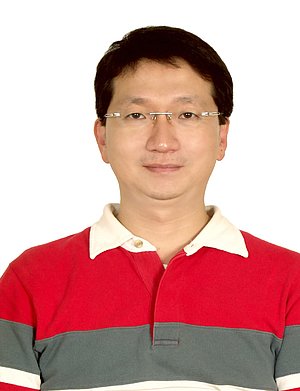Plenary presentations:
| Director for Science of the European Spallation Source (ESS) in Lund |
| ESS and its contributions to future functional materials and nanotechnology |
Prof. Dr. Andreas Schreyer is the Director for Science of the European Spallation Source (ESS) in Lund, Sweden since 2016. Before he joined ESS, he was head of the Institute of Materials Research at the Helmholtz-Zentrum Geesthacht, Germany and director of the German Engineering Materials Science Center (GEMS). He also was the speaker of the Helmholtz research program “Research with Photons, Neutrons, and Ions” (PNI) coordinating the research with these three probes at all major large scale facilities in Germany. Prof. Schreyer teaches at Hamburg University since 2001. He received his venia legendi (professoral degree) in 2000 and his Ph.D in 1994 from the Ruhr-University Bochum. He was awarded a Heisenberg stipend of the Deutsche Forschungsgemeinschaft in 2000, a Feodor Lynen stipend of the Alexander von Humboldt foundation in 1998 and the prize for the best Ph.D. thesis of the Ruhr-University Bochum in physics in 1994. Prof. Schreyer's research focuses on the analysis of lightweight materials, biomaterials, and magnetic nanostructures with X-rays and neutrons at large scale facilities. During his career he has been heavily involved with the design, construction and scientific use of scattering and imaging experiments at neutron and synchrotron sources. He has lead the construction of experiments at the Institute Laue Langevin in Grenoble, France, the PETRA III synchrotron storage ring at DESY, Hamburg and the Heinz-Maier-Leibnitz Zentrum in Garching, Germany. He now is responsible for the scientific experiments and infrastructure at the European Spallation Source in Lund, Sweden. |
GSI Helmholtzzentrum and Technische Universität Darmstadt, Germany |
Material science and nanostructures produced with GeV heavy ions |
Christina Trautmann is the head of the Materials Research Department of the GSI Helmholtz Center in Darmstadt (Germany) who operates a large scale accelerator facility for swift heavy ions. Christina graduated in physics at the Technische Universität in Munich and received her PhD from the University of Frankfurt. Her research activities cover interaction processes of energetic, MeV to GeV, heavy ions with matter with focus on ion-beam induced modifications including defect and track formation in different material classes, performance limits of materials applied in high-dose environment and exposed to prolonged radiation (e.g., outer space, nuclear waste storage, reactor or accelerator environment, etc.) and the question how solids respond to the simultaneous exposure to pressure and ion beams. Together with her group and students from the TU Darmstadt, Christina operates several beamlines at the GSI accelerator facility and provides support to internal and external users for irradiation experiments that are dedicated to materials science including in-situ sample analysis by microscopic and spectroscopic techniques. She also promotes heavy ion beams for ion-track nanotechnology where the ion beam is used as tool for producing high-aspect-ratio micro- and nanostructures such as nanochannels and nanowires with tailored properties. Christina teaches at the Technische Universität Darmstadt and is Editor of the Journal Nuclear Instruments and Methods in Physics Research, Section B, Beam Interactions with Materials and Atoms. More information under: https://www.gsi.de/en/work/research/appamml/materials_research.htm |
| Physics Department & CICECO, University of Aveiro, Portugal School of Natural Sciences and Mathematics, Ural Federal University, Ekaterinburg, Russia |
| Nanoscale Piezoelectric Materials: Structure, Properties, Applications |
Dr. Andrei Kholkin is one of the world leaders in the characterization and imaging of functional materials with the emphasis on ferroelectrics and multiferroics. He received his PhD degree in Solid State Physics from the A. F. Ioffe Physical-Technical Institute (St. Petersburg, Russia). Afterwards he held research positions in Leibniz Institute for Solid State and Materials Research (Germany), Swiss Federal Institute of Technology (Switzerland) and Rutgers University (USA). He is currently research coordinator and head of the advanced microscopy of functional materials laboratory of the CICECO-Aveiro Institute of Materials of the University of Aveiro (Portugal). His group develops multifunctional materials (including ferroelectrics, multiferroics and polar biomaterials) and scanning probe microscopy techniques for their study. He is a co-author of about 500 technical papers in this area including multiple reviews and book chapters. He was a coordinator of three European projects on functional materials and currently serves as an Associate Editor-in-Chief for the IEEE Transactions on Ultrasonics, Ferroelectrics and Frequency Control (TUFFC). He is a member of editorial boards of several scientific journals and serves in advisory boards of international conferences on ferroelectrics. He is a member of the Ferroelectric Committee of IEEE and was a recipient of the “Excellency” award from the Portuguese Foundation for Science and Technology. Dr. Kholkin is IEEE Fellow for his achievements in the development of electromechanical characterization tools and got a Ferroelectrics Recognition award from IEEE. |
| Head of the Kanbar Laboratory for Nanomaterials, Bar-Ilan University |
| Making the Hospital a Safer Place by the Sonochemical coating of all its Textiles and Medical Devices with Antibacterial Nanoparticles |
Prof. Em. Aharon Gedanken obtained his M. Sc. from Bar-Ilan University, and his Ph. D. degree from Tel Aviv University, Israel. After his postdoctoral research at USC in Los Angeles. He got a lecturer position at BIU on Oct. 1975. He spent two sabbatical years at AT&T Bell Laboratories in 1980-8l, and 1987-88 as well as a summer in 1984. He also has done research at NIDDK, NIH in the summers of 1989, 1990 and 1991. In 1994 he switched his research interest from Spectroscopy to Nanotechnology. His special synthetic methods of nanomaterials include: Sonochemistry, Microwave Superheating, Sonoelectrochemistry, and Reactions under Autogenic Pressure at Elevated Temperatures (RAPET). Since 2004 he is mostly focused on the applications of nanomaterials. Gedanken has published 790 per-reviewed manuscripts in international journals, and has applied for 42 Patents. His H-Index is 86 according to the WEB of SCIENCE. Gedanken has served as the Department Chairman as well as the Dean of the Faculty of Exact Sciences at Bar-Ilan University. He is on the editorial boards of 5 international journals. He still leads a group of 13 research people. He was a partner in five EC (European Community) FP7 projects one of them, SONO, was coordinated by him. This project was announced by the EC as a “Success Story”. He is a partner in PROTECT a textile project in Horizon 2020. He was the Israeli representative to the NMP (Nano, Materials, and Processes) committee of EC in FP7. He was awarded the prize of the Israel Vacuum Society in 2009 and the Israel Chemical Society for excellence in Research in Feb. 2013. |
| National Science Foundation, Arlington, VA |
| Understanding Chemical Reactions Triggered by Defects on Energetic Materials and Interfaces. Insight from Quantum Chemistry |
Education Ph.D. Chemical Physics University of Latvia, Riga, Latvia (04/96) Professional Experience Program Director (2002 – present), National Science Foundation, Arlington, VA Office of the Director, Office of International Science and Engineering (02/2011 - present)
Office of the Director, Office of Integrative Activities: (03/2008 – 02/2011)
Directorate for Mathematical and Physical Sciences, Division of Materials Research (12/02- 04/2008)
Embassy Science Fellow US Embassy in Tbilisi, Georgia (10-11/2016)
Embassy in Moscow, Russian Federation (05-07/2010)
Research Interests Condensed Matter Physics, Solid State Chemistry, and Materials Science, including but not limited to:
Publications
Academic Experience Professor (Adjunct) (12/07 - present) Department of Materials Science and Nuclear Engineering, A. James Clark School of Engineering, University of Maryland, College Park, MD
Professor (Adjunct) (01/05 - 06/11) Physics Department, University of Nevada, Las Vegas, NV Research Faculty (06/99-09/01), Office of Naval Research Fellow (08/97-06/99) Teaching experience
Memberships and Selected Honors
Selected research funding
Publications Monographs, Book Chapters, Invited and Review papers
Journal Articles
Peer-reviewed Conference Proceedings
|
Professor at the Optoelectronics Research Centre, University of Southampton, UK |
| Advancing the art of femtosecond laser writing |
Peter G. Kazansky studied physics in Moscow State University and received Ph.D. under supervision of Nobel Laureate for the invention of laser A.M. Prokhorov from the General Physics Institute in 1985. He was awarded the Leninskii Komsomol Prize in 1989 for the pioneering work on "Circular photogalvanic effect in crystals". From 1989 to 1993 he led a group in the GPI, which unraveled the mystery of light-induced frequency doubling in glass. In 1992 he joined the ORC at the University of Southampton where since 2001 he is a professor pursuing his interests in new optical materials and phenomena. More recently he pioneered the field of ultrafast laser nanostructuring in glass leading to invention of “5D memory crystal,” which holds a Guinness world record for the most durable data storage medium. From 2014 he is also a director of the International Centre of Laser Technologies in Mendeleev University of Technical Technologies. He served as Vice-Chair of the Committee on Glasses for Optoelectronics of International Commission on Glass and is a Fellow of Optical Society of America. |
Invited presentations:
| MAX IV Laboratory |
| MAX IV laboratory in Lund, Sweden: research portfolio, present status expected performance |
Konstantin Klementiev studied solid state physics in Moscow Engineering-Physics Institute and received his doctor’s degree in 1998 with work in high temperature superconductivity and XAFS as the main experimental technique. While working as a postdoc and beamline scientist at DESY/Hamburg, he became more and more interested in methods and instrumentation in synchrotron radiation applications. Consequently, this interest resulted in the development of a ray-tracing and wave propagation toolkit xrt comprising physical models of synchrotron radiation sources and x-ray optics along with associated analysis tools (xrt.readthedocs.io). This development influenced and also gained from the design, assembly and commissioning of two XAFS/XES beamlines, first at Alba synchrotron and then at MAX IV, while he was working as beamline principal in Barcelona (2006-2013) and Lund (from 2013). His present focus is in bringing Balder – the XAFS/XES beamline of MAX IV – into full user operation. |
Institute of Physics, University of Tartu, Estonia |
A Role of Large Scale Facilities in the Development of Novel Functional Materials |
Marco Kirm, born 1965, is a professor of experimental physics at Institute of Physics, University of Tartu. He graduated University of Tartu cum laude as a physicist in 1991 and obtained his PhD „ Spectroscopy of highly charged ions, small molecules and solids under VUV excitation”, supervised by Prof. Indrek Martinson, at Lund University in 1995. During 1997-2004 he worked at Hamburg University in the group of Prof. Georg Zimmerer as a post-doctoral researcher. As a beam-line scientist he was responsible for operation of the famous SUPERLUMI station (HASYLAB, DESY), designed for luminescence spectroscopy in VUV. Since 2004 after returning to Estonia, Marco Kirm has been in duties of a research director and director of Institute of Physics at University of Tartu. He was a Vice Rector for Research of University of Tartu during 2012-2017. In 2012 Marco Kirm was elected to the Latvian Academy of Sciences as a foreign member. In 2013 he received Baltic Assembly medal for the development of cooperation between Baltic States. His research interests cover wide range of novel functional wide gap materials (incl. nanomaterials) applicable as LED phosphors, scintillators. He is also carrying out research on basic phenomena such as relaxation processes of electronic excitations and their dynamics by luminescence spectroscopy in wide time, temperature and energy range; ultrafast radiative processes (applications in PET tomography); creation of radiation defects in wide gap solids. He also focuses on novel optical diagnostics methods for thin dielectric films, optical materials and actively contributes to development luminescence spectroscopy setups under synchrotron radiation in Lund and Hamburg. His publication list includes 244 papers cited more than 3000 times (h-index 30) in the Web of Science. In European Research Area he has been acting as an Estonian representative at the COST (Cooperation in Science and Technology, EU) in “Materials science, physics and nanosciences” domain committee. The INTERREG Baltic Sea Region innovation projects “Science Link” (2011-2014) and “Baltic Tram” (2016-2019) with a focus on access of large scale facilities and university labs by enterprises for their R&D are under the leadership of Marco Kirm in Estonia. He has been organising various international scientific and educational events as chairperson: European Science Olympiade EUSO2016 (Tartu, May 7-14, 2016); 9th International Conference on Luminescent Detectors and Transformers of Ionizing Radiation – LUMDETR 2015 (20-25.09.2015, Tartu); Conference on functional materials and nanotechnologies FM&NT-2013 (in Tartu, April 21-24, 2013) and the most recent FM&NT-2017 held in Tartu April, 24 – 27, 2017. Marco Kirm’s continuously updated complete CV can be found at the Estonian Research Portal. |
| Department of Materials Science and Chemical Engineering, Stony Brook University and Division of Chemistry, Brookhaven National Laboratory |
| A Neural Network Approach for Structural Characterization of Metal Nanoparticles and Clusters |
Anatoly Frenkel is a Professor in the Department of Materials Science and Chemical Engineering at the Stony Brook University and a Senior Chemist (Joint Appointment) at the Division of Chemistry, Brookhaven National Laboratory, having joined in the Fall of 2016. Prior to his appointment at SBU, he has held a number of different positions, including Associate and then appointed Full Professor and Chair, Physics Department at Yeshiva University, a Research Scientist and Principal Investigator in Materials Research Laboratory of the University of Illinois at Urbana-Champaign. He received M.Sc. degree from St. Petersburg University and Ph. D. degree from Tel Aviv University (with Prof. A. V. Voronel), all in Physics, followed by a postdoctoral appointment at the University of Washington (with Prof. E. A. Stern). His research interests focus on development and applications of in situ and operando synchrotron methods to solve a wide range of materials problems, with most recent emphasis on catalysis, electromechanical materials, filtration materials, quantum dots, physico-chemical properties of nanoparticles, as well as machine learning methods for structural analysis and design of nanomaterials. He is a founding Principal Investigator and the Spokesperson for the Synchrotron Catalysis Consortium at Brookhaven National Laboratory. He is a Fellow of the American Physical Society and a Fellow of the Empire Innovation Program at the New York State. He is the author of over 300 peer-reviewed publications, which have been cited > 14,000 times, and has given over 250 invited lectures at conferences and university, government and corporate laboratories. |
| Chemistry Department, Saint -Petersburg State University |
| Theoretical modeling of point defects in crystals |
Robert A. Evarestov graduated St. Petersburg State University as theoretical physicsist in 1960. He obtained his PhD in the Department of Theoretical Physics at St. Petersburg State University in 1964 (supervisor Prof. Marija Petrashen, coworker of Academician V.A.Fock), Habilitation degree -in the same Department in 1977 „Molecular models in the electronic structure theory of crystals“. From 1968 he woks at the Department of Quantum Chemistry of St. Petersburg State University (Professor – from 1979). In 1990-1994 he was Director of the Chemistry Institute of St. Petersburg State University, in 1994-1998 he was First Vice Rector of St. Petersburg State University. Since 1999 till present time he is Head of Department of Quantum Chemistry of St. Petersburg State University. His research interest cover symmetry of crystalline solids (the monograph „Site Symmetry in crystals„ has been published by Springer in 1993 , second edition in 1997). He is interested also by the application of quantum chemistry methods to perfect and defective crystals (the monograph „Quantum Chemistry of Solids„ has been published by Springer in 2007, second edition in 2012). Now his interests cover symmetry and quantum chemical study of monoperiodic nanostructures (nanotubes, nanowires). His monograph „Theoretical Modeling of Inorganic Nanostructures. Symmetry and ab-initio calculations of nanolayers, nanotubes and nanowires“ has been published by Springer in 2015. He is Foreign Member of Latvian Academy of Science (from 2005), Humboldt Foundation Awardee (1998). His publication list includes over 280 papers indexed in WOS and cited more than 2600 times, his Hirsh index is 28(Web of Science data, December 2016). |
| Institute of Physics, Polish Academy of Sciences (Warsaw, Poland) Lviv Polytechnic National University (Lviv, Ukraine) |
| Photoluminescence quantum yield as a test of quantum cutting processes in down-converting phosphors |
Research Interests Optical and thermally activated spectroscopy of point defects, transition metal and rare earth ions in complex oxide crystals with garnet, perovskite and other types of structure. Energy and charge transfer processes between point defects and activator ions in the crystals. Photochromic properties of the crystals. Optical and luminescent properties of new solid-state laser, scintillator and phosphor materials. Thermally and optically stimulated luminescence for radiation dosimetry. Current Research Activities Research project of the European Regional Development Fund (POIG 01.01.02-00-108/09), 2009-2014, Topic: Novel Materials and Innovative Methods for Transformation and Monitoring of Energy (MIME), Principal Investigator. Education and Employment 1992-1998: Higher education in Lviv Polytechnic National University. Specialty: Physics and technology of electronic materials. Honors Personal 6-month scholarship of the Polish Ministry of Education (2001‑2002). |
| Senior researcher at the Institute of Physics, University of Tartu, Estonia |
| New features of hot intraband luminescence |
Vitali Nagirnyi is a recognized expert in the field of time-resolved spectroscopy of wide gap solids under UV, VUV, XUV and X-irradiation. The main directions of his research are related to the investigation of the band structure of wide-gap crystals, relaxation processes and mutual interaction of electronic excitations (incl. the studies under extreme excitation conditions provided by modern free electron lasers and powerful short-wavelength fs-lasers), energy transfer from host matrices to intrinsic and extrinsic (e.g., impurity ions) luminescence centres. He has an extended research experience in working with various pulsed excitation sources such as synchrotron radiation (MAX-Lab, HASYLAB), free-electron laser FLASH (DESY), tunable OPO fs-laser systems (Laser Research Centre, University of Vilnius), electron guns (Tartu), and HHG devises (Saclay). V. Nagirnyi has been one of the leading researchers in a number of national grants awarded by Estonian Research Council and a Centre of Excellence project funded by European Commission and structural funding in Estonia. He has taken an active position in several international collaborations of INCO-COPERNICUS program, Crystal Clear Collaboration at CERN and in several COST actions (“Fast advanced Scintillator Timing” and “Advanced X-ray spatial and temporal metrology”). He is a recognized reviewer of journals Radiation Measurements, Journal of Luminescence, Vacuum, an Editorial Board member of Vacuum and has been a guest Editor of several IEEE TNS special issues. In his publication list, there are 133 papers according to Web of Science database. A complete CV of Vitali Nagirnyi can be found at the Estonian Research Portal. |
| Laboratory of Quantum Chemistry and Molecular Simulations, Photochemistry Center RAS, Federal State Institution “Federal research center Crystallography and Photonics Russian Academy of Science” (FRC Crystallography and photonics RAS) FRC C&P RAS Russian Academy of Sciences |
| Theoretical modeling in nanophotonics |
SCIENTIFIC TITLE 1992 – Professor (Physical Chemistry), N.N. Semenov Institute of Chemical Physics, Russian Academy of Sciences, Moscow. CURRENT POSITION Chief researcher, laboratory of Quantum Chemistry and Molecular Simulations, Photochemistry Center RAS, Federal State Institution “Federal research center Crystallography and Photonics Russian Academy of Science” (FRC Crystallography and photonics RAS) FRC C&P RAS Russian Academy of Sciences, ul. Novatorov 7a, Moscow, 119421 Russia, Moscow, full-time (main) job EDUCATION: 1956-1962 D.I. Mendeleev Institute of Chemical Technology, Moscow, Department of Physical and Chemical Engineering, specialty: isotope separation and application technology. SCIENTIFIC DEGREES 1968 – PhD (Physical Chemistry), Institute of Organoelement Compounds, USSR Academy of Sciences, Moscow. PhD Thesis Title: "π-Electronic Structure of some Conjugated Systems with High Effective Charges on Atoms" EMPLOYMENT HISTORY 1962–1968 Institute of Organoelement Compounds, Russian Academy of Sciences. The scope of activity was basic research in the broad field of chemistry of organoelement compounds. 1968–1972 Moscow Institute of Fine Chemical Technology. The scope of activity was education of students in the field of chemical technology. 1972–1976 All-Union Research and Development Institute of Oil Chemistry and Processing "VNIPINeft". The scope of activity was research and development in the field of oil chemistry and processing. 1976–1988 Institute of Organic Chemistry, Russian Academy of Sciences. The scope of activity was basic research in the broad field of organic chemistry and organic catalysis. 1988–1997 Institute of Chemical Physics, Russian Academy of Sciences. The scope of activity was basic research in the broad field of chemical physics. 1997–2016 Photochemistry Center, Russian Academy of Sciences, The scope of activity is photochemistry of dyes, supramolecular systems, and functional materials for optical chemical sensors, organic electronics and photonics. 2016–up to now Photochemistry Center RAS, Federal State Institution "Federal research center Crystallography and Photonics Russian Academy of Science" (FRC Crystallography and photonics RAS) FRC C&P RAS Russian Academy of Sciences Photochemistry Center, Russian Academy of Sciences (from 21.03.2016). 2009–up to now Department of Condensed Matter Physics, National Research Nuclear University "MEPhI". The scope of activity is education of students in the broad field of theoretical and experimental physics. RESEARCH INTERESTS
KEY WORDS Quantum chemistry, molecular dynamics; ab initio, DFT, TDDFT, CASSCF, MCQDPT; electronic spectra, band shapes, line shapes; multiscale atomistic simulation; nano materials; chemical optical sensing, organic electronics and photonics Web sites: http://www.photonics.ru/; http://mephi.ru/; CONTACT INFORMATION Name: Alexander Bagaturyants PERSONAL INFORMATION Date of Birth: 25.11.1939 LIST OF PUBLICATIONS (Currently, 222 publications).
BOOKS
|
Department of Condensed Matter Spectroscopy, Institute of Spectroscopy, Russian Academy of Sciences |
Marina Popova is Chief researcher and Head of the Fourier-Spectroscopy Laboratory in the Institute of Spectroscopy, Moscow. Her research interests include high-resolution spectroscopy, spectra of rare earths in crystals, spectroscopy of magnetic insulators, spectroscopy of multiferroics, phase transitions, hyperfine, interionic, electron-phonon interactions in crystals. At present, she is Leader of the joint Russian-Taiwanese project “Crystals for Quantum Memory”, of several projects supported by Russian science foundations. Education: Moscow Institute of Physics and Technology (Diploma with honors). The diploma work "Kinetics of the generation of a ruby laser with a concentric resonator" (1964) was performed at the Luminescence Laboratory of the Lebedev Physical Institute, RAS, under the supervision of А.М. Leontovich. Postgraduate study at MIPT and Lebedev Institute. PhD degree: The thesis "Dynamics of ruby laser" (supervisors M.D. Galanin and A.M. Leontovich) defended at the Lebedev Physical Institute (1968). Dr. Sci. degree: The thesis “High-resoluion Fourier spectroscopy in studying crystals with rare-earth ions” defended in the Institute of Spectroscopy, RAS (1992). Professor in optics: 2001. Employment: 1975 – present: the Institute of Spectroscopy, RAS 1968 – 1975 – the Latvian State University, the Problem Laboratory of Semiconductors. In 1969, she has assembled and launched the first laser in the Baltic States. The study of multiphoton absorption in alkali-halide crystals, the lecture course "Lasers". |
| Department Head for Microelectronic Materials and Nanoanalysis at the Fraunhofer Institute for Ceramic Technologies and Systems in Dresden, Germany |
Application of X-ray microcopy in materials science and nanotechnology |
Ehrenfried Zschech is Department Head for Microelectronic Materials and Nanoanalysis at the Fraunhofer Institute for Ceramic Technologies and Systems in Dresden, Germany, which he joined in 2009. His responsibilities include multi-scale materials characterization and reliability engineering. Ehrenfried Zschech received his Dr. rer. nat. degree from Technische Universität Dresden. After having spent four years as a project leader in the field of metal physics and reliability of microelectronic interconnects at Research Institute for Nonferrous Metals in Freiberg, he was appointed as a university teacher for ceramic materials at Freiberg University of Technology. In 1992, he joined the development department at Airbus in Bremen, where he managed the metal physics group and studied the laser-welding metallurgy of aluminum alloys. From 1997 to 2009, Ehrenfried Zschech managed the Materials Analysis Department and the Center for Complex Analysis at Advanced Micro Devices in Dresden. In this position, he was responsible for the analytical support for process control and technology development in leading-edge semiconductor manufacturing, as well as for physical failure analysis. He holds an adjunct professorship at Faculty of Chemistry of Warsaw University, Poland, as well as honorary professorships for Nanomaterials at Brandenburg University of Technology Cottbus and for Nanoanalysis at Technische Universität Dresden. Ehrenfried Zschech is member of the Board of Directors of the Materials Research Society (MRS) and Honorary Member of the Federation of the European Materials Societies (FEMS). |
| Uppsala University, Div. Solid State Physics, Dept. Engineering Sciences |
Novel multi-functional self-cleaning, air cleaning and thermochromic films for the built environment |
Lars Österlund is Professor in solid state physics with specialization in environmental science and technology at Uppsala University. He is board member of the Uppsala Center for Photon Sciences, and is vice-chairman of the International Science Program. He is the co-founder of the Swedish Society of Vibrational Spectroscopy and was its president from 2010-2017. He is currently also CEO of a spin-off company developing micro-structured diamond waveguides. Prof. Österlund has a PhD from 1997 from Chalmers, were his thesis work involved fundamental surface science studies of photo-induced surface reactions on single crystal surfaces employing a broad range of surface spectroscopic methods and reaction kinetic modelling. His postdoc research involved fundamental studies of surface reactions on single crystal surfaces employing scanning tunneling microscopy (STM), Monte-Carlo simulations of surface kinetics, and development of a high-pressure STM with atom-resolved imaging capabilities up to 1 bar and atomistic proof that was used to bridge the so called pressure gap in catalysis. A general theme of his current research is development of catalytic materials, including solar light responsive materials, such as photocatalytic materials, self-cleaning surface coatings, solid state gas-sensors and smart windows and façades within the general theme of technologies for improved indoor climate. His group studies fundamental and applied aspects of surface reactions on solid surfaces and photo-induced reactions on semiconducting materials with applications in indoor air cleaning, self-cleaning, and water cleaning. Recent internationally recognized results from his research include the invention of a simple method to modify acid-base properties of oxide surfaces based on photo-fixation of electrophilic or nucleophilic molecules from gas-phase (Handelsbanken Innovation Prize 2009; subject of commercialization), which also has been extended to a new low-temperature photocatalyst with superior sustained activity. His group has recently developed a new photocatalytic multilayer material for sustained indoor air-cleaning films for smart windows that allows for one-pass cleaning of VOC up to low ppm levels. Other recent activities include developed a new PVD methodology to prepare (001) facet-controlled anatase TiO2 nanoparticle films for photocatalysis applications; discovery of a general structure-reactivity relationship of photocatalytic anatase and rutile titania nanoparticles (patented); development of colloidal lithography for fabrication of ordered nano-patterned multi-layered photonic bandgap materials for photocatalysis applications, invention of microfabricated diamond IR waveguide methods for biomolecular imaging and integration with affinity layer technology (patented); and development of Raman imaging methods in nanomedical applications. Prof. Österlund has published 226 scientific publications including 6 invited book chapters, and he holds 6 international patents. |
| Director of the Ural Center of Shared Use “Modern Nanotechnology”, Ural Federal University, Ekaterinburg |
| Shapes of isolated domains in uniaxial ferroelectrics |
Work abroad:
Memberships
Organization of International Conferences:
Awards: Honorary Worker of High Professional Education of Russian Federation, since 2005 Publications: Papers: more than 400; Supervisor of 23 PhD theses. Research interests:
Selected publications. Chapters in books:
Papers
|
University of Duisburg-Essen, Institute for Materials Science |
Electrocaloric effect in barium titanate based ceramics and single crystals |
Professional education:
Research and Professional Experience:
Research Interests:
Significant Awards and Honors: Gottschalk-Diederich-Baedeker-Preis-2016 for the best Habilitation in the natural and engineering sciences at the University of Duisburg-Essen in 2015. Professional Activities Reviewer for various scientific journals including “Nature Materials“, “Physical Review Letters”, “Physical Review B”, “Applied Physics Letters”, “Journal of Applied Physics”, “Ferroelectrics”, “Journal of the European Ceramics Society”, “Journal of Physics D: Applied Physics”, “Smart Materials and Structures Invited presentations 18 invited talks at international scientific conferences Cumulative Total Number of Articles Published in Peer Reviewed Journals: More than 140 papers in peer reviewed journals, three book chapters. H-index=31, number of total citations > 3300 Postgraduate students supervised Total number of PhD students supervised/co-supervised, 5 |
| VU Team Leader |
| Multicomponent metal oxide systems for optical and magnetic applications |
Prof. Aivaras Kareiva is expert in the preparation and characterization of superconducting, optical and bioceramic materials bulk and thin films. He has published over 310 research articles in high level international journals. His Hirsch Index is 24. His articles were cited 2497 times. A. Kareiva visited many foreign universities (Helsinki University of Technology, Stockholm University, Harvard University, Rice University, Hasselt University, University of Saarland, University of Tuebingen, Masaryk University Brno, Tallinn University of Technology, University of Malta, Muenster University of Applied Sciences, Research Centre for Natural Sciences, Hungarian Academy of Sciences, University of Bern, Clausthal University of Technology, University of Cologne, University of Maribor, University of Geneva, Kyushu University, University of Venice, University of Strasbourg, Georgetown University and others). He supervised successfully 27 PhD students at Vilnius University, several postdocs and many foreign trainees. A. Kareiva participated or conducted several Research projects on optics and lasers with funding from NATO, the National Grant from Lithuania, the European Sixth Framework Programme, COST Action and Horizon 2020. Contacts: Aivaras Kareiva (aivaras.kareiva@chgf.vu.lt) – VU Team Leader |
| President of the Lithuanian Academy of Sciences Professor at Vilnius University, Faculty of Physics (Lithuania) |
| Dielectric Response of the Methylammonium Lead Halide Solar Cell Absorbers |
Jūras Banys graduated from Vilnius University in 1985, obtained PhD in 1990 and the second degree (doctor habilitatus) in 2000. Between 1988 and 1989, he was at Oxford University, UK, as a PhD student under the supervision of Prof. A. M. Glazer. He was awarded Humboldt Research Fellowship for post-doctoral scholars and spent the period of 1993–1995 at Leipzig University, Germany. J. Banys published over 300 scientific papers. Currently his research group has been working on Relaxor Ferroelectrics and multiferoic materials. These investigations include single crystals, ceramics, thin films. J. Banys won the Lithuanian National Prize for Science in 2002. In 2000 received P. Brazdžiūnas Award of the Lithuanian Academy of Sciences in the field of Experimental Physics. He is a member of the Lithuanian Physical Society, a member of the Lithuanian Materials Research Society, Member of the Lithuanian Academy of Sciences, Foreign member of the Latvian Academy of Sciences, Correspondent Member of the Saxonian Academy of Sciences in Leipzig, member of the international advisory board of ECAPD (European Conference on Applications of Polar Dielectrics), member of the international advisory board of EMF (European Meeting on Ferroelectrics), member of the international advisory board of IMF (International Meeting on Ferroelectrics). J. Banys has contributed to numerous Lithuanian national and international conferences as a Chair and Organizing or Program Committee Member. |
| Department of Materials and Ceramics Engineering and CICECO – Aveiro Institute of Materials, University of Aveiro, Portugal |
| Tuneable Magnetic Co(II)-Containing Layered Double Hydroxides |
Andrei Salak completed of his PhD in 1994 at the Institute of Solid State and Semiconductor Physics (Minsk, Belarus). In 2002, he received a post-doctoral position in CICECO - Centre for Research in Ceramics and Composite Materials at the University of Aveiro (Aveiro, Portugal). At present, A. Salak is an Invited Researcher at CICECO. He specializes in crystal structure determination and dielectric characterization of inorganic solids, particularly perovskite-like materials and layered ion exchangers. A. Salak is a co-author of more than 100 papers in international peer-reviewed journals with over 1000 citations and 1 patent. He has completed the supervision of more than 10 Master students and 2 PhD students. A. Salak is the Principal Coordinator of the project 'Tuneable multiferroics based on oxygen octahedral structures' (TUMOCS, 2015-2018, grant 645660) that receives funding from the European Union’s Horizon 2020 programme MSCA-RISE. http://tumocs.web.ua.pt/. The project joints 7 academic organisations and 1 SME from 6 countries. Besides, A. Salak is a Local Coordinator of the project MULTISURF (MSCA-RISE, grant 645676). He is also a PI of the R&D project POCI-01-0145-FEDER-0166 funded by P2020 COMPETE and FCT-Portugal. |
Experimental Physics VI, Julius Maximilian University, Würzburg, Germany Bavarian Center for Applied Energy Research (ZAE Bayern e.V.), Würzburg, Germany |
| Low-Dimensional Organic Conductors for Thermoelectric Applications |
Jens Pflaum studied physics at the Ruhr-University in Bochum, Germany, where he received his PhD in 1999 for his work on magnetic resonance studies on exchange coupled ferromagnetic thin films. As a post-doc fellow at Princeton University from 1999 until 2001 his research focus shifted to organic thin films and their electronic transport properties. Returning back to Stuttgart University, Germany, in 2001 he extended this work to molecular single crystals which can be considered reference systems for studying fundamental questions on charge carrier and exciton transport in narrow bandwidth semiconductors and, in particular, its interaction with lattice dynamics. In 2008 he received a professorship at the Institute of Experimental Physics VI at Julius Maximilian University in Würzburg, where since then he is addressing questions on energy research and novel applications of organic semiconductors. By the strong application driven research he was appointed group manager for ‘Organic Photovoltaics and Electronics (OPE)’ at the Bavarian Center for Applied Energy Research (ZAE Bayern e.V.) in 2008 and holds membership in various scientific committee boards, including that of the ‘International Conference on Organic Electronics (ICOE)’ or the ‘International Conference of Photovoltaics’. Jens Pflaum’ s scientific interests span a broad range of topics, including fundamental questions on electronic and optical excitations in organic semiconductors and their implementation in thin film devices, such as OLEDs, transistors or photovoltaics. Recently he extended his activities to molecular based quantum devices, demonstrating the first, electrically driven single photon source at room temperature, as well as to thermoelectric applications of low-dimensional organic conductors. |
| BioCat of Fraunhofer IGB (Germany) |
| Functional materials for the CO2 –based electrosynthesis of ethylene oxide |
Short biography Dr. Luciana Vieira studied chemistry and obtained her MSc. in materials science at the University of Campinas (Brazil). From 2008 to 2014 she was involved in several academic and industrial projects on electrodeposition of metals from deep eutectic solvents, ionic liquids and aqueous electrolytes at CEST (Center for Electrochemical Surface Technology, Austria). She obtained her PhD in 2014 at the Technische Universität Graz (Austria), where she continued her research on metal electrodeposition as a postdoc fellow. In 2015 she conducted postdoctoral research at the University of Campinas (Brazil) investigating the spectroelectrochemical properties of oxide nanomaterials. Since 2016 she has been working on the development of new electrocatalysts for energy conversion and storage, including electrochemical CO2 reduction, at the institute branch BioCat of Fraunhofer IGB (Germany). Since 2018 she is coordinating the European project CO2EXIDE (co2exide-eu.e-p-c.de). Publication in Journals
Oral Presentations in Conferences
Poster Presentations
|
| St. Petersburg Academic University and Peter the Great St. Petersburg Polytechnic University |
| Plasmonic nanoislands on glass: formation and properties |
Education: 1970-1976 undergraduate studies at Leningrad Polytechnic Degrees: M.Sci. (Radiophysics) in 1976 from Leningrad Polytechnic Positions: Since 2012: Full Professor at St. Petersburg Academic University and part-time Professor at Peter the Great St. Petersburg Polytechnic University (Head of Dept. of Physics and Technology of Nanostructures) Visiting Positions: Visiting Professorship: University of Bordeaux, France; Shanghai Inst. of Ceramics, China; Cornell University, USA; University de Santiago de Compostella, Spain; Swiss Federal Polytechnic, Lausanne. Teaching: Lecturing: Solid State Optics, Quantum Electronics, Optical Information Processing, Integrated Optics, Nonlinear Optics. Research interests: Material Science, Physics of Glasses, Diffusion and Ion Exchange, Nanostructures, Plasmonics, Nonlinear Optics, Integrated Optics, Semiconductor Lasers. |
Chair professor Department of Materials and Optoelectronic Science |
| Preparation and characterization of heteroepitaxial Cu2O thin film and devices on metallic substrates |
Education: 2000, Ph.D. School of Optics/(CREOL), University of Central Florida, Orlando, FL. USA Experience:
Areas of Expertise: single crystal growth, condensed matter physics E-mail: mitch@faculty.nsysu.edu.tw Biography: Professor Mitch Chou joined the faculty at NSYSU in 2004 and served as chair of the Department of Materials and Optoelectronic Science, 2012~2015. His current researches include laser, compound semiconductor, high temperature superconductor, topological insulator, and scintillator. He was a visiting scientist at some institutes in Germany, including Max Planck Institute for Solid State Research (MPI), Stuttgart ; Institute of Applied Physics, Karlsruhe University ; Institute of Crystal Growth (IKZ), Berlin ; Paul Drude Institute (PDI), Berlin. Prof. Chou is the recipient of:
|
